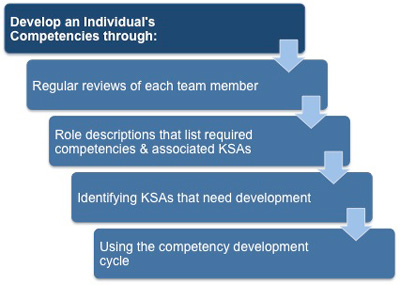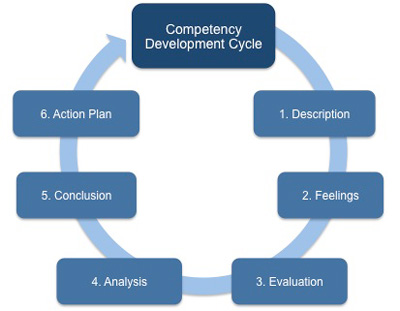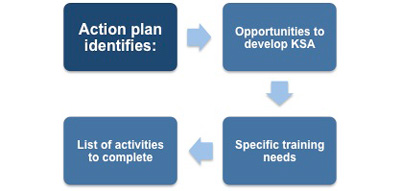Developing Competencies at Work
You should take time to discuss how your team members have been developing their own competencies as an integral part of their regular performance reviews. These discussions can also consider ways in which the individuals can expand their current competencies in order to prepare themselves for future promotion.
It is usually a good idea to present this in terms of a staged development, as this will encourage them to see each incremental step as achievable, rather than an unattainable leap between competency levels.
 |
One way you can do this is to incorporate the 'competency development cycle' into your appraisal and review meetings.
This technique uses a series of questions that you and the team member need to ask yourselves as you reflect on how they behaved during a particular event or incident. It allows you to create a personal action plan that addresses the issues that are identified by the answers to these questions. The aim of this plan is to help the team member develop the competencies they need to perform their role to a higher standard or to gain promotion.
The competency development cycle consists of six steps:
 |
1. Description - What happened?
Consider the causes of the event and how they developed. Your main focus here is the facts and figures that best describe what occurred and who was involved. You are looking for a chronological account of what happened.
2. Feelings - What were you feeling and thinking?
Work with the individual to understand how they felt at the time of the event. This does not solely take into account how they felt personally, but how the other people involved felt and how that affected the individual. Present your own interpretation and discuss how appropriate the member's reactions were.
You may want to analyze the individual's thought process during the event to assess how well it matched that required by someone in their role or in the role that they aspire to.
3. Evaluation - What was good and bad about the experience?
Divide a sheet of paper or spreadsheet into two columns: one for what you both feel was good about the experience of the event, and another for what was bad. You and the individual go through all your notes from the first two steps and allocate them to one of these columns and reference them to the role competencies.
Depending on the nature and severity of the incident you may want to include the experiences of others involved so that you have a complete picture of the overall impact and repercussions of the event.
4. Analysis - What went well? What didn't go well?
In this fourth step you are looking at the perceptions of the event in terms of the team member's KSAs. Look at this from the different perspectives of those involved. In our previous example this would be John, his manager, the customer, and the technical support team, as well as the interactions between these parties. You will often find differing views depending on 'who' you ask about what went well.
For example, the customer may think it all went well because his server was restored quickly, but be totally unaware of the conflict within John's organization that occurred in order to achieve this result.
5. Conclusion - What else could have been done? What have you learnt?
You and your team member now discuss what else could have been done instead of what occurred, and decide whether or not the end result would have been better than what actually happened.
Decide what has been learnt as a result of going through the cycle. You must look at this from the individual's perspective and in terms of the required KSAs.
6. Action Plan - If this situation arose again what would you do?
The resulting action plan that is produced as a result of completing this cycle must be focused on developing any required KSAs. The plan should have only a few well-defined goals that can be achieved in a relatively short timeframe. Remember that this is a cyclical process and frequent iterations with a few objectives will work best. If you complicate the action plan with too many goals you will lessen the chance of achieving any of them.
 |
You should have a clear idea of what the team member would do differently if the situation arose again. You can then highlight those KSAs you want them to develop and list ways this can be achieved, for example through training, mentoring, or a secondment to other areas of the organization.
As part of the performance management process you may seek out and identify opportunities to develop the individual's competencies. This may involve seconding them to another department or a specific project so that they can develop the competency. You can also take the opportunity to mentor them through this experience and work with them to develop their career, and ultimately bring more value to the organization.
The cyclical nature of the process offers both of you the opportunity to agree a staged action plan that is easily reviewed and updated according to how well the required changes in behavior have been accomplished.
You may also be interested in:
Competency Development Process | Competency Framework Example | Example Competency Framework | Measure Competencies | Knowledge, Skills and Attitudes.



